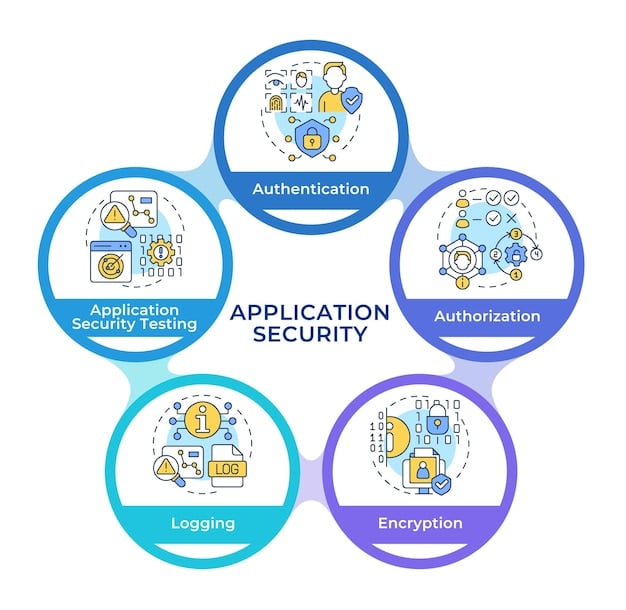Understanding Startup Intellectual Property: Protecting Your Innovations in 2025

Understanding Startup Intellectual Property in 2025 is crucial for securing a startup’s innovative edge, involving strategic asset management like patents, trademarks, and copyrights to protect unique creations and competitive advantages in the evolving business landscape.
In the competitive landscape of startups, **understanding startup intellectual property: protecting your innovations in 2025** is not just an option, it’s a necessity. Failing to protect your unique ideas and creations can leave your business vulnerable and hinder its potential for growth.
Why Intellectual Property Matters for Startups in 2025
In 2025, the digital landscape is more competitive than ever. For startups, intellectual property (IP) offers a critical edge, providing a shield against copycats and a foundation for sustainable growth. It’s about securing your innovations and building a valuable brand.
Competitive Advantage
Intellectual property is the backbone of a startup’s competitive advantage. Patents, trademarks, and copyrights protect innovations from being replicated, providing exclusive rights that allow a startup to stand out in crowded markets. This exclusivity attracts investors, customers, and partners.
Attracting Investment
Venture capitalists and angel investors look for companies with strong IP portfolios. A well-protected invention or brand is a valuable asset that demonstrates a startup’s potential for long-term success. This assurance makes startups a more attractive investment opportunity.
- Patents increase company valuation by securing exclusive rights to inventions.
- Trademarks protect brand identity, fostering customer loyalty and recognition.
- Copyrights protect original works, enabling startups to license and monetize content.
Strong IP protection not only safeguards your innovations but also enhances your startup’s credibility and market value, making it more appealing to potential investors and partners.

Key Types of Intellectual Property for Startups
Understanding the different types of intellectual property is crucial for a startup. Each type serves a unique purpose in protecting various aspects of your business, from inventions to brand identity.
Patents
Patents protect inventions, granting exclusive rights to use, sell, and manufacture the invention for a specific period. There are different types of patents, including utility patents, design patents, and plant patents, each covering different aspects of innovation.
Trademarks
Trademarks protect brand names, logos, and slogans. They prevent others from using similar marks that could cause confusion among consumers. A strong trademark is essential for building brand recognition and customer loyalty.
- A registered trademark provides legal protection against infringement.
- Trademarks help customers easily identify and trust your products or services.
- Brand recognition is a powerful asset that sets you apart from competitors.
Choosing the correct type of intellectual property is essential for comprehensive protection, ensuring your startup’s assets are secure and defensible.
Developing an Intellectual Property Strategy
An effective IP strategy is a roadmap for protecting your startup’s most valuable assets. It involves identifying key innovations, assessing potential risks, and implementing measures to safeguard your intellectual property.
Identifying Core Assets
Begin by identifying the key innovations and creations that set your startup apart. Determine which of these assets are eligible for patent, trademark, or copyright protection. This initial assessment will guide your IP strategy.
Conducting IP Audits
Regular IP audits help identify potential vulnerabilities and ensure your intellectual property is adequately protected. These audits should assess your IP portfolio, monitor for infringements, and update your protection strategies accordingly.
An effective IP strategy includes regular monitoring for infringements, enforcement actions against unauthorized use, and continuous adaptation to changes in the legal and market landscape.

Protecting Trade Secrets in the Digital Age
Trade secrets are confidential information that provides a competitive edge. Unlike patents, trade secrets are not publicly disclosed and can last indefinitely as long as they remain confidential.
Implementing Confidentiality Measures
Protecting trade secrets requires strong confidentiality measures. This includes limiting access to sensitive information, using non-disclosure agreements (NDAs), and implementing robust cybersecurity protocols.
Employee Training
Educating employees about the importance of trade secret protection is crucial. Training should cover best practices for handling confidential information, reporting potential breaches, and understanding the legal consequences of misappropriation.
- NDAs protect against unauthorized disclosure of trade secrets.
- Access controls limit who can view and use confidential information.
- Cybersecurity measures protect against digital theft of trade secrets.
Vigilance and proactive measures are essential to maintaining the confidentiality of trade secrets and preserving your competitive advantage.
Understanding the Costs of Intellectual Property Protection
Securing intellectual property protection involves various costs, including application fees, attorney fees, and maintenance fees. Understanding these costs is essential for budgeting and prioritizing your IP investments.
Budgeting for IP Protection
Allocate sufficient funds for patent applications, trademark registrations, and copyright filings. Consider the long-term value of your intellectual property and prioritize investments accordingly.
Exploring Funding Options
Explore funding options for IP protection, such as government grants, venture capital, and angel investors. A strong IP portfolio can attract funding and support your startup’s growth.
Securing IP protection is a vital investment, safeguarding your innovations and brand identity while enhancing your startup’s long-term value and competitive position.
Navigating Intellectual Property Disputes
Intellectual property disputes can arise from infringement claims, licensing disagreements, or trade secret misappropriation. Understanding how to navigate these disputes is essential for protecting your IP rights.
Seeking Legal Counsel
Engage experienced IP attorneys to represent your interests in disputes. They can advise you on the best course of action, negotiate settlements, and litigate cases in court.
Alternative Dispute Resolution
Consider alternative dispute resolution methods, such as mediation and arbitration, to resolve IP disputes efficiently and cost-effectively. These methods can often lead to quicker and more amicable resolutions than litigation.
- Mediation involves a neutral third party facilitating negotiations.
- Arbitration involves a neutral arbitrator making a binding decision.
- Settlement negotiations can resolve disputes without going to court.
Resolving IP disputes requires a strategic approach, focusing on protecting your IP rights while minimizing legal costs and business disruptions.
| Key Point | Brief Description |
|---|---|
| 💡 Patents | Protect inventions with exclusive rights for a limited time. |
| 🛡️ Trademarks | Safeguard brand identity and prevent consumer confusion. |
| 🔒 Trade Secrets | Protect confidential information for a competitive edge. |
| ⚖️ IP Disputes | Seek legal counsel and consider mediation for efficient resolution. |
Frequently Asked Questions
▼
Intellectual property refers to creations of the mind, such as inventions, literary and artistic works, designs, and symbols, names, and images used in commerce.
▼
IP protects a startup’s unique creations, providing a competitive advantage and attracting investors. It can increase valuation and ensure market exclusivity.
▼
The main types include patents (for inventions), trademarks (for brand identity), copyrights (for creative works), and trade secrets (for confidential information).
▼
Startups can use NDAs, limit access to sensitive data, implement cybersecurity measures, and train employees on confidentiality protocols.
▼
Startups should seek legal counsel, gather evidence of infringement, and consider mediation or litigation to protect their IP rights and seek damages.
Conclusion
In conclusion, understanding and protecting intellectual property is paramount for startups in 2025. By implementing a robust IP strategy, securing necessary protections, and staying vigilant against infringements, startups can safeguard their innovations, build strong brands, and create a sustainable competitive advantage in the evolving business landscape.





